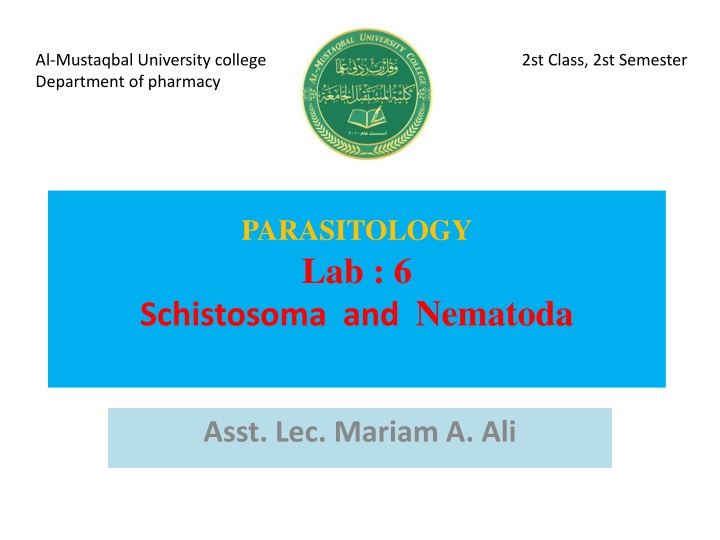
Parasitology: Schistosoma, Nematoda, and Diagnosis Methods
Explore the classification of parasites including Protozoa, Helminthes, and Arthropoda. Learn about Schistosoma, responsible for schistosomiasis, and Nematoda parasites like Ascaris causing ascariasis. Discover diagnostic methods for identifying these parasites.
Download Presentation

Please find below an Image/Link to download the presentation.
The content on the website is provided AS IS for your information and personal use only. It may not be sold, licensed, or shared on other websites without obtaining consent from the author. If you encounter any issues during the download, it is possible that the publisher has removed the file from their server.
You are allowed to download the files provided on this website for personal or commercial use, subject to the condition that they are used lawfully. All files are the property of their respective owners.
The content on the website is provided AS IS for your information and personal use only. It may not be sold, licensed, or shared on other websites without obtaining consent from the author.
E N D
Presentation Transcript
Al-Mustaqbal University college 2st Class, 2st Semester Department of pharmacy PARASITOLOGY Lab : 6 Schistosoma and Nematoda Asst. Lec. Mariam A. Ali
Classification of parasites divided into three main groups: A Protozoa single-celled organism, multiply in human host, All protozoans have 2 important stages of life: Trophozoite and Cyst 1 1- -Sarco a-subphylum: Sarcodina b-subPhylum:mastigophora 2- Phylum: Ciliophora 3- Phylum: Sporozoa B-Helminthes (worms) multicellular worms, do not normally multiply in human host 1- Phylum: platyhelminthes 2- Phylum: Nematoda 3- Phylum: Acanthocephala C-Arthropoda multicellular, do not normally multiply in human host 1- Phylum: insecta 2- Phylum: Archneida Trophozoite and Cyst Sarcomastigophora
Schistosoma is a genus of trematodes, commonly known as blood flukes. They are parasitic flatworms responsible for a highly significant group of infections in humans termed schistosomiasis Kingdom: Animalia Phylum: Platyhelminthes Class: Trematoda Order: Diplostomida Family: Schistosomatidae Genus: Schistosoma The three main species infecting humans are Schistosoma haematobium Schistosoma japonicum Schistosoma mansoni Schistosomiasis is diagnosed through the detection of parasite eggs in stool or urine specimens. Antibodies and/or antigens detected in blood or urine samples are also indications of infection
Phylum: Nematoda Nematodes that commonly parasites humans includeforv examples ascarids (Ascaris). Ascaris is a genus of parasitic nematode worms known as the "small intestinal roundworms", which is a type of parasitic worm. One species, Ascaris lumbricoides, affects humans and causes the disease ascariasis. Kingdom: Animalia Phylum: Nematoda Class: Chromadorea Order: Ascaridida Family: Ascarididae Genus: Ascaris Species: Ascaris lumbricoides
The standard method for diagnosing ascariasis is by identifying Ascaris eggs in a stool sample using a microscope.






















